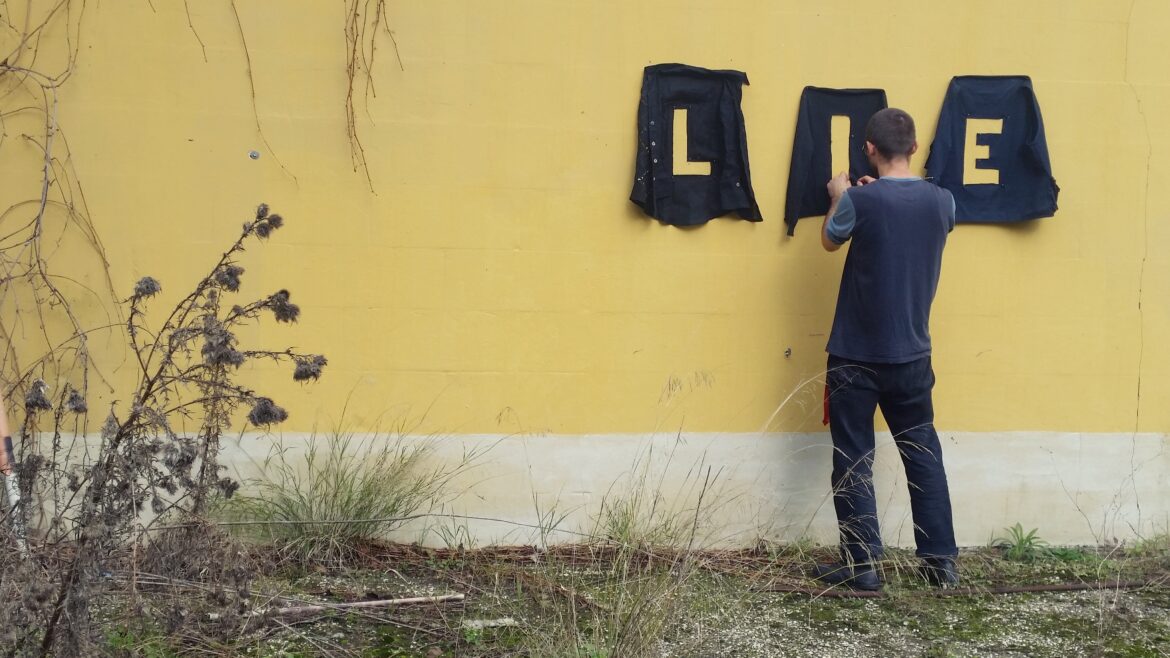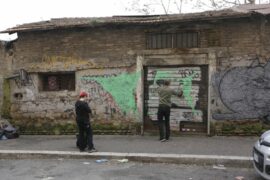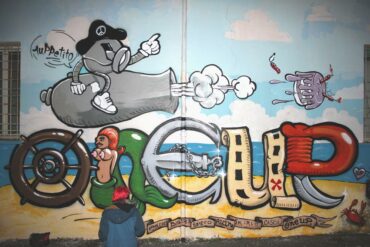Nar and his works in Athens
There are some trips giving you more than others – their own path, places that amaze you, communities where you’re welcomed with open arms. That is what happened to me in Athens in September.
A destination chosen at the last moment and made by instinct but that it uncovered one of the best street art scenes I have ever seen so far. And it’s exactly in Athens where I had a pleasure to meet, or better to say, to run into, the artist named Iakovos Volkov (Nar). Even if it was just within three intensive days, I discovered and appreciated his “abandoned art” in a former factory in the suburb, we had a chance to discuss everything – from his street art vision to the contemporary art, through his past as a writer until his artistic and life path.
Nar was an excellent guide (thanks to him I could get in touch with the “real Athens” and the real local life), a great artist and a good friend. For these reasons, before leaving Greece I invited him to spend some time in Italy, managed by Urban Lives.
Words are important: from street graffiti to factories
For Iakovos Volkov, Russian artist who’s first based in Thessaloniki and then in Athens, words are more than important, they came out to be fundamental.
Iakovos, or Jakob as I call him, is a kind and sensible person, intricate and brilliant at the same time, and it doesn’t surprise me that in Athens he is surrounded by good friends with such a stimulating environment.
He’s also one of those thoughtful people, in the best meaning of this word, who never talks too much to anyone but as soon as he feels comfortable with the others, he starts sharing ideas, thoughts and impressions.
Connection between us came up immediately; also because of the importance that we both give to words.
Even his sarcasm and his sharp irony, maybe not so easy to understand for someone else, make him either an interesting and funny person or a strange one. His way of choosing words is not only noticed in conversations with him or in a way he jokes or communicates but also in representation of his inspiration and creativity.
During our long and pleasant conversations I found out that words, the same as quotes and concepts, have been as a leitmotif of his artistic path.

His need to communicate was always constant, since that time when he was tagging all over the city, alone and with his crew. In his life as a writer, words he wrote on walls, commonly in large letters, were not just a simple repeating of his name, but most of the times, quotes and ideas, either with a provocative, or with an erotic meaning, but always unexpected.
Some of his tags are still flaunted on walls of streets and buildings in few Greek cities, some were censured, some others – canceled; one of his writing even inspired to name a restaurant; but I’m pretty sure that no matter what, all of them left a sign in lives of those who passed by and observed them.
He moved from the hardcore period of graffiti writer, when he even used to write using a steak from roofs, to a period where he was more focused on artistic concept and interaction with urban and architectural environment.
An example of these works are two telephonic tanks covered with messages taken from real and virtual conversations.

I won’t spend too much time in private stories behind these conversations, but I can tell you, also cause they’re written in Greek, that those are quotes full of emotions, some small pieces of a daily life that goes public, giving the observer a chance to take time to think, and to ask himself some questions. In addition, let us pass to another constant element in Nar’s art, as I just said, the wonder.
His experimentation brought him from the street to more self-controlled situations, such as solo or group exhibitions in museums or art galleries. Using the canvas, letters and words, always perfectly chosen, became three-dimensional, as a result of right choice of material, some nails, sprays or small different items.
From the exhibition of his art only for ‘some lucky ones’, the next and more recent step (the one he could deepen in Italy with me) was reaching the solitary dimension, the one of abandoned places.
I’m really happy that some of his art and creativity was “left” also in my city.
Nar, ideas, creativity and power of observation
One of the things that impressed me the most about Nar is his deep empathy, related to both – people and places surrounding him. It’s hard to forget his astonishing ideas coming out from daily situations, like it was his quest for “R” letter on old gates all over streets of Rome. Iakovos thinks that a trip or a walk must always have moving power of discovery, adventure, a connection with parallel world made of thoughts, projects; in one word – Art.
Exactly with this spirit was born the “Nar’s triangle”, 3 different letters found in the urban fabric of 3 different cities which on the map make a shape of triangle. Another significant moment of his personal way of observing world was our visit to Trevi Fountain.
While I was telling him to come closer and have a proper look, even if I was annoyed seeing so many tourists concentrated on taking pictures or eating ice creams, his eye was caught by a small and not well-preserved hidden church, just few steps away from the fountain. He checked everything that surrounds us, in each corner of the city, in objects, materials and even shops’ windows; everything can be a potential inspiration. I will never forget, for example, when we were in city-center; we arrived close to one shop trying to understand how Christmas decoration where attached to the wall, while all people passing through were staring at us.
We were close to take some of those pieces back home with us!
Nar, like few other artists, showed me new aspects of a city, new way of checking around you, collecting ideas, to look for a small detail with its own charm that no one else notices. He taught me to give right importance to words, always.
3 factories, 3 installations, many stories
When Iakovos reached Rome, I had a concrete itinerary in my mind that included abandoned factories or old-fashioned cultural places full of history which could be perfect for his installations.
At the same time, all materials he could use were full of history; poor people’s clothes, rescue blankets he brought from Athens, to create a virtual bridge between our two countries. I also made my contribution with some of my old clothing; full of memories I was happy to share with him. What is behind every single installation is a complicated and hard work, it is difficult to understand if you check only the final result.
Everything used in the three Roman installations, clothes, metal nails and all other materials, were chosen after attentive visit of the chosen place.
The artist always get inspired by surrounding environment: from the history of an area, from lights to features of what you have around; either they are walls or objects or elements of nature.

Sometimes an installation can take many days and unpredictable amount of time in order to leave the message that he wants to express and words he wants to chose; from the practical side, it is passing the technics, variety of colorful objects you want to use. I was really happy to witness three of his creative processes and to have a chance to participate, even in a small part, with some ideas, some stories and mainly with a choice of places (well checked before his arrival to Italy).
Within 2 weeks, however, some unexpected things happened.
For example, in MAAM Museum, which I had a chance to write about in the past, after an agreement with their curator Giorgio De Finis and one local representative, our planned installation couldn’t take a place due to some internal problems. Anyway, I want to thank everyone, especially Michela, Giorgio and Carlo for their hospitality; was a great pleasure to come in such extraordinary place like as never before.
Other unexpected situations we had to face, were rain, luckily lasting just one day and a half, and people in abandoned factories, which forced us to come back there in the following days.
For the first installation I took Iakovos to the factory where I’ve previously been with Vegan Flava and Ken Plobot, and where I took the Austrian Skirl earlier in August. The two artists were so kind not to post any picture which could reveal the exact location of factory, in order to not to get me in troubles but mostly for expected visit of Greek artist Nar. Coming back to that suggestive and at the same time adventurous place was still fascinating and after so many raids, I started feeling it like mine (I would have visit it one more time going with Skirl and Ruin, my guests in another trip). Even if light wasn’t so good, Nar made, in one afternoon, his first Roman work, the written sign “forget”. I found it really suggestive reminding me of another installation of him, which I had a pleasure to observe in person in Athens, the one named “Remember”.


Both of them are in abandoned factories, but in the Greek version the rescue blankets are on the golden part, in Rome on the silver ones. Might be for a location in an abandoned factory, particularly in shadow, that “forgetting” tastes a bit bitter, almost like a determined choice, although like suffered whisper.
A reflexive and cathartic journey, started in Greece, and finished in Italy.
Or maybe not, this is just the message I got from his art; everyone is free to get its own interpretation or emotion.
Interesting thing to mention: in case of shadowed wall or a cloudy day, pictures of the work are the same important for artist as the installation; those were kindly taken by my friend Skirl whom I’d love to thank for this gesture.
I also want to write few lines to say that the interaction between all artists I invited to “work” in Rome, I hope, can keep going on, creating magic connections among distant artists.
Going back to Iakovos, we moved on to another factory for the second installation, but for some reasons we had to leave, choosing a new spot in another factory, maybe not so impressive or suggestive like the other one but for sure less dangerous.
Honestly, the meaning of word suggestive, I never considered being so personal before meeting Nar.
A crumbling wall, a hole in the rooftop, a particular color, traces of history, people passing or staying, scaring or not objects, presence or absence of vegetation… everything can make difference in such a place.
In this factory, there was a column in the middle of a wall that caught his attention: covered by moldy carpet of green moss. It’s strange, I’ve been in the factory before, but I never stopped staring at that thing, and I would never thought it could be so enthusiastic for him.
I would have appreciated his happiness only at the end of the installation: colored stripes from old clothes made alive and full of memories, some even mine, that abandoned place, where all colors were shining on that green mirror.


For the last installation and location, we got lucky. Walking in the suburb of Rome, always deeply observing all surroundings to find hidden places, we found an abandoned factory, where no one seemed ever to be before us.
With an amazing sunny day and with the feeling to be, like ever before, in “our” secret place far from unexpected visits or non-welcomed observers, the artist chose a nice yellow wall, with a suggestive industrial landscape in the background, to create his last work.
This time clothes were not rolled and hanged, but cut using scissors, giving a life with empty spaces in the middle to the letters in order to read the written “LIE”.


All and all, three stories, three works, three places, three amazing experiences I am happy I had the chance to live. I really hope they can impress you too.
At the end, I want to thank very much Nar for the company and for all amazing talks we had, and the last but not the least, for the amazing words.
More info about NAR:
Website
Facebook Page
Instagram



